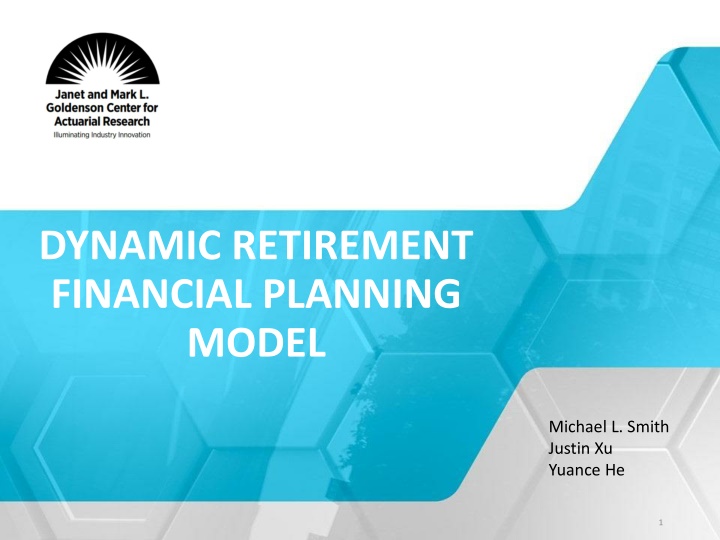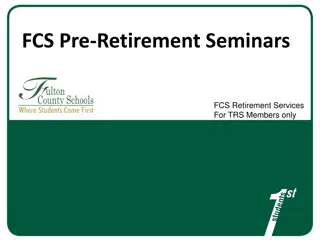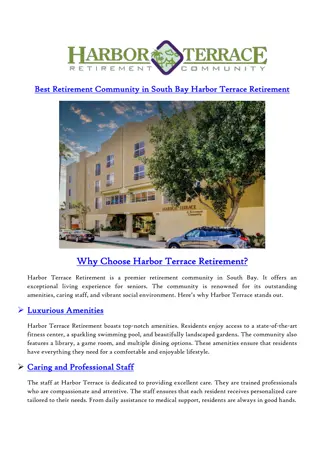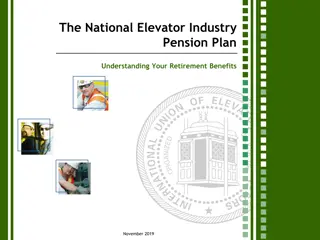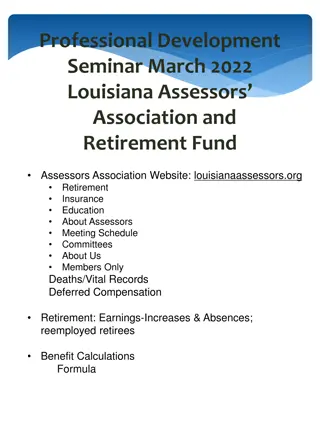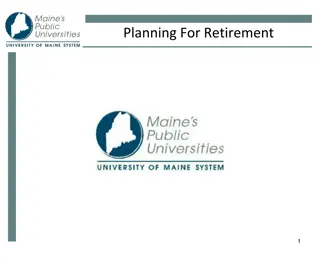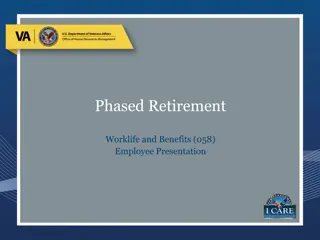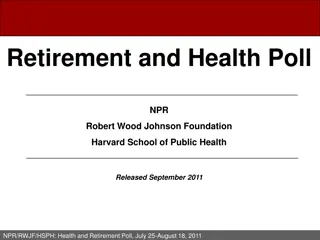Dynamic Retirement Financial Planning Model and Current Challenges
Background research led to the development of the dynamic retirement financial planning model, addressing risks like overspending or underspending during retirement. Current retirement planning faces crises as many enter retirement without a solid plan. Experts consider retirement income planning a complex issue, with challenges in maximizing spending while ensuring financial security. Innovations like the JourneyGuide aim to provide solutions to these challenges.
Download Presentation

Please find below an Image/Link to download the presentation.
The content on the website is provided AS IS for your information and personal use only. It may not be sold, licensed, or shared on other websites without obtaining consent from the author.If you encounter any issues during the download, it is possible that the publisher has removed the file from their server.
You are allowed to download the files provided on this website for personal or commercial use, subject to the condition that they are used lawfully. All files are the property of their respective owners.
The content on the website is provided AS IS for your information and personal use only. It may not be sold, licensed, or shared on other websites without obtaining consent from the author.
E N D
Presentation Transcript
DYNAMIC RETIREMENT FINANCIAL PLANNING MODEL Michael L. Smith Justin Xu Yuance He 1
Background Research work on this topic has generated two PhD theses in actuarial science Justin Xu and Qintian Sun Research work has been applied to develop cutting-edge financial planning models for JourneyGuide 2
The Risk for Retirees Spending too much and running out of money when they are still alive Spending too little and leaving a huge amount of money when they die Spending during retirement varies depending on state of health of retiree and an extended illness can quickly exhaust a retiree s assets 3
Current Retirement Financial Planning Maximize annual spending under an investment strategy Do not incorporate actuarial probabilities of mortality and morbidity Do not capture changes in actual investment performance compared to expected Generally assume a level of ruin, typically 5% 4
Current Retirement Planning Crisis Millions entering retirement every year without a plan Built JourneyGuide to answer two simple questions: How much can I spend in retirement after taxes and inflation? Will I run out of money before I run out of breath? 6
[Retirement Income Planning] is a really hard problem. It s the hardest problem I ve ever looked at. William Sharpe Nobel Laureate in Economics 7
Where we were Built an Excel model to determine the spending amount with annual cash flows and the purchase of an annuity The Good News: We were able to calculate the answer to how much? The Bad News: Took several hours to iterate over many runs of 1000 simulations each Conclusion: Professor Sharpe was right! Too time- consuming to be commercially viable 8
Partnership with the Goldenson Center Built recursive, closed-form algorithm to calculate pre-tax spending given inflation assumptions, pre-retirement savings, capital infusions, Soc Sec, pension, and annuity payments 5000 Monte Carlo simulations on 19 asset classes using Cholesky decomposition Proprietary tax formula to convert to after-tax spending Reduced calculation time to 0.2 second leveraging Julia Result: Immensely powerful, commercially viable solution to a pressing problem facing millions of people 10
Where it is taking us Partnerships with carriers Annuity modeling - Demonstrate impact in a dynamic, living illustration New product design Developing index and structured products with a leading investment bank More productive advisors with more AUM and annuity sales 12
Incorporate Insurance Product Multi-Year Guaranteed Annuities (MYGA) Defined as Fixed Rate or CD-type Annuities, is a type of fixed annuity that provide a pre-determined and contractually guaranteed interest rate for a specified period of time Illustrative Examples Assume initial assets of $1M 5-year MYGA at the beginning of retirement, fixed rate = 4% Asset Market: conservative, moderate, aggressive 5% ruin probability 13
Results of Financial Planning Example Asset MYGA Opt Opt Annual Withdraw $39,857 $44,090 $38,905 $43,195 Allocation 0% 77% 0% None =2%, =2% 5Year, r=4% None =3%, =5% 75% 5Year, r=4% None 5Year, r=4% 0% 41% $50,449 $54,925 =10%, =15% 14
Comments on Examples Incorporating MYGA to financial planning: Increases annual spending by $4.5K for each market scenario Neutralizes high volatility in aggressive investment Optimal allocation of MYGA decreases with increasing asset return 15
Why MYGAs Work Partially immunize the portfolio during critical pre-retirement accumulation years and post-retirement spending years Buffer sequence of return risk when it is most dangerous Buffer by allowing for reduced market exposure during MYGA durations with serial reinvestment back into markets through 10% annual withdrawals and laddered MYGA maturities 16
Why Buffer Sequence Risk If a Retiree Relies Upon And Returns Hit at the Wrong Time Right Time An Average Annual Return 5.02% $33,696 5.02% $68,938 Arithmetic Mean Safe Spending A Given Compound Growth Rate Geometric Mean Safe Spending 4.64% $44,254 4.64% $68,515 A Given Level of Volatility Standard Deviation Safe Spending 8.49% $35,148 8.49% $69,032 17
Incorporate HLE Defined as the expected future lifetime that one stays healthy Termination from a healthy state occurs by death or disability Disability uses a long term care definition which is inability to perform some of the activities of daily living The only recovery from disability is death In contrast, Unhealthy Life Expectancy (ULE) is the expected future lifetime that one stays unhealthy HLE + ULE = Life Expectancy (LE) 18
Financial Planning Illustrative Example Assume initial assets of $1.5M, i = 6%, HLE = 22 years and ULE = 8 years Assume p.v. of basic expenses = 20% of initial assets Assume basic expenses are double over ULE period and there are no discretionary expenses 19
Results of Financial Planning Example Financial planning not based on HLE: Annual spending over LE of 30 years approximately $103,000 Financial planning model based on HLE: Annual spending over HLE approximately $112,000 Annual spending over ULE approximately $41,000 Additional annual discretionary spending is $9,000 or approximately $750 of additional monthly spending 20
Incorporate Kalman-Filter Re-calibration Defined as an algorithm that uses the actual performance of daily market return from previous year as sample data to estimate the real and Combines the result with our prediction at the beginning of previous year based on credibility principles. 21
Incorporate Kalman-Filter Re-calibration Illustrative Example Assume = 4% and = 10% at beginning of retirement Future market either goes up to 1= 8% and = 10%, or goes down to 2= 1.5% and = 10% Initial asset is $1M Duration is 30 years Choose the median path from 1000 simulations as the actual path given by 1and 2 Comparison between 5%-ruin simple method and Kalman-Filter Re-calibration method 22
Results of Financial Planning Example Simple Kalman-Filter Ending account value ( 1) $5,669,360 $61,074 Average opt withdrawals( 1) $32,051 $100,713 Ruin Probability 0% 0% $5.6M left in the account under simple method With Kalman-Filter average annual spending is three times that of the simple method No ruin for both methods 23
Results of Financial Planning Example Sample Kalman-Filter Ending account value ( 2) $128,272 $15,221 Average opt withdrawals( 2) $32,051 $36,273 Ruin Probability 26.4% 0% Even under a bad market, Kalman-Filter can still make retiree spend $4000 more per year on average without ruin 26.4% ruin probability means that if retiree chooses to stay with $32,051 annual spending, it will be highly likely for the retiree to run out of money before he dies 24
Comments on Examples Eliminates any ruin during retirement under different market performance The entire algorithm is fully automated Increases average annual spending and also spends retirement assets more efficiently 25
A Couple of Our Next Steps Develop multiple spending curves with a dynamic spending component when individuals have more than enough assets to support Safe Spending Develop a methodology to replace Target Date Funds with more efficient portfolios which use a combination of investments and annuities that are customized to an individual s personal situation rather than the off-the-rack, one-size-fits-all approach of TDFs 26
